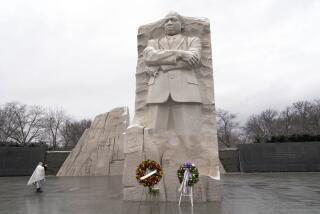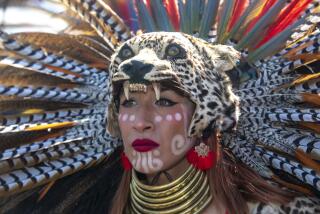Revelry, Reflection at Kwanzaa Celebration : Festivities: Bowers Museum event gives African Americans, including those never before exposed to the holiday, a chance to look back and forward at year’s end.
- Share via
SANTA ANA — The Kwanzaa celebration Saturday afternoon at the Bowers Museum of Cultural Art was many people’s first taste of the seven-day African American holiday. Nate Malcolm of Irvine said it won’t be his last.
*
“I was never exposed to it,” said Malcolm, 21, who won a wooden African mask in a raffle at the end of the festivities. “People talked about it and I’m into new things, seeing what the community is celebrating, so I came.”
Kwanzaa, Malcolm discovered, “is a celebration to bring African Americans together in a positive light. It kind of gives everyone a sense of coming together as one. You look ahead and see the positive values that bring everybody together and you always look at your past to remember your heritage.”
Kwanzaa, which means “first fruits” in Swahili, is celebrated in homes and community centers from Dec. 26 to Jan. 1. Rooted in African tradition, it comes at year’s end, when families reflect on the past year and focus on nguzo saba, or seven principles, that will help them lead prosperous lives in the coming year.
Created in 1966 by Maulana (Ron) Karenga, chairman of the Black Studies Department at Cal State Long Beach, Kwanzaa is a non-religious holiday in which traditional African clothing is worn to gatherings. African music, dance and food are also plentiful.
At the museum Saturday, community leaders garbed in traditional African dress, took turns lighting the mishuma , or candles, that symbolize the principles of umoja (unity), kujichagulia (self-determination), ujima (collective work and responsibility), ujama (cooperative economics), nia (purpose), kuumba (creativity) and imani (faith).
The candle-lighting ceremony is a large part of the festivities. Each day of Kwanzaa, a different candle is lit. While a person lights a candle, he or she also speaks about what a particular principle means to them.
“This candle symbolizes umoja, “ said Joyce Jordan, co-publisher and co-editor of The Black Orange, a newsletter for Orange County African Americans, as she lit the first candle. “Unity in the family, community and the nation. It is the first and foundational principle. Without it, the others mean nothing. Unity begins at home.”
Unity has been the core of Lawrence Brown’s family since they began observing Kwanzaa three years ago.
“We celebrate the family being together with our good health and the good health of others,” said Brown, sitting with his family toward the back of the packed room. “It’s helping other people, strangers and taking care of our home.”
Justin Hamilton, 11, wanted to go to the Kwanzaa celebration after he saw a soap opera Friday in which the characters performed the candle-lighting ceremony. He asked his grandmother if they could go.
“We have a membership to the museum and we decided to come,” said Hamilton, a student at Samuel E. Talbert Middle Schoolin Huntington Beach. “In history classes, they talk too much about Europeans. They don’t talk much about African Americans. I don’t know why we don’t, but I want to. It’s interesting.”
Kwanzaa is a large part of 13-year-old Jason Jordan’s life. Saturday, he led the audience in seven cries of “harambee,’ ‘ a term that symbolizes unity, collective work and struggle.
“I’ve learned a lot,” Hamilton said. “I’m going to try to remember the seven principles. I want to try coming next year too. It’s cool.”
Saturday’s celebration was presented by the African Cultural Arts Council.
More to Read
Sign up for The Wild
We’ll help you find the best places to hike, bike and run, as well as the perfect silent spots for meditation and yoga.
You may occasionally receive promotional content from the Los Angeles Times.






